Flexographic Printing Market Size
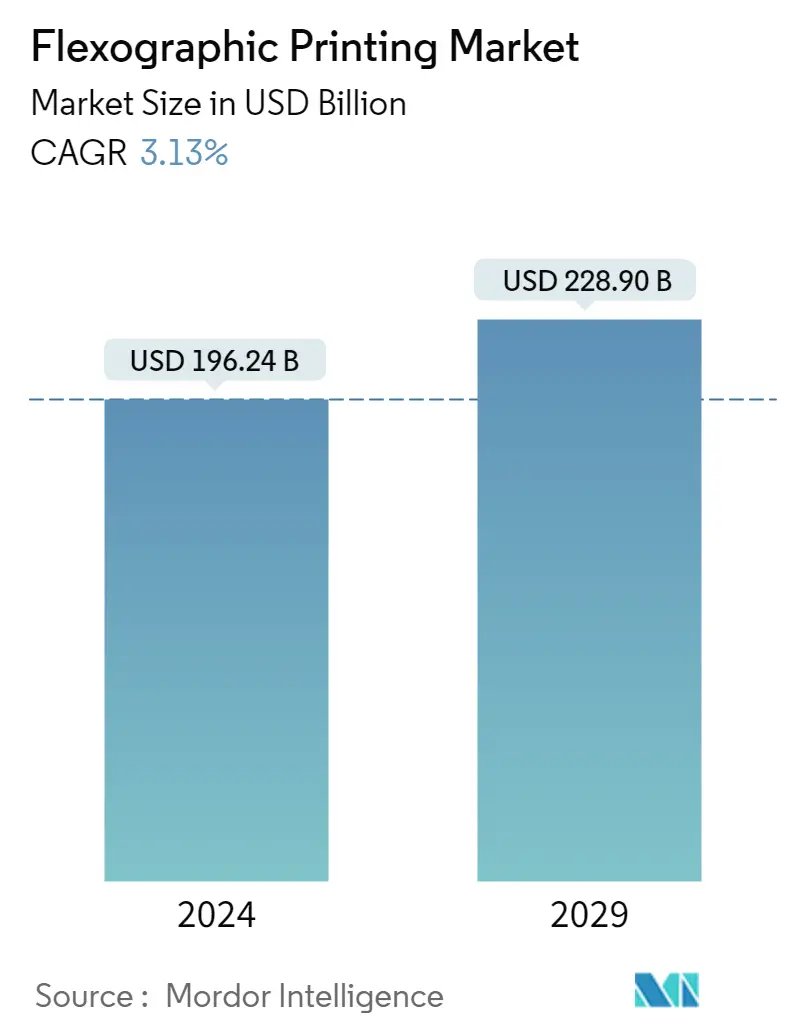
| Study Period | 2019 - 2029 |
| Market Size (2024) | USD 196.24 Billion |
| Market Size (2029) | USD 228.90 Billion |
| CAGR (2024 - 2029) | 3.13 % |
| Fastest Growing Market | Asia Pacific |
| Largest Market | Asia Pacific |
Major Players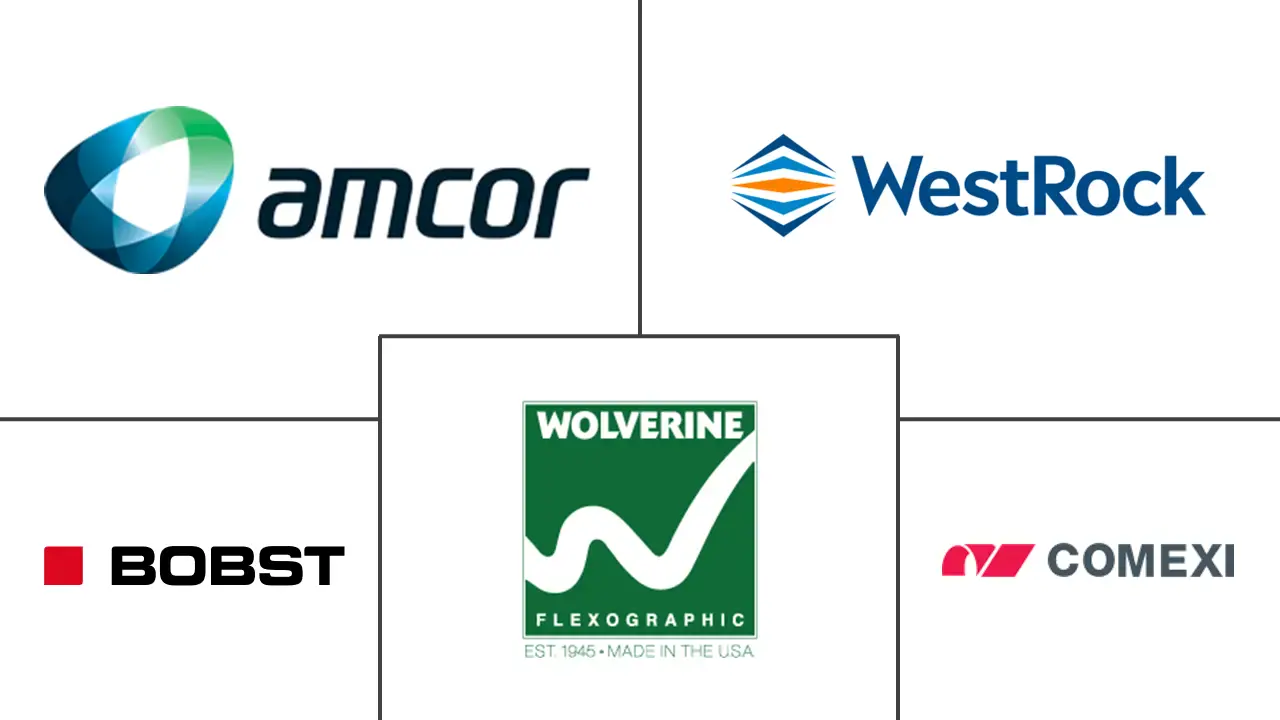
*Disclaimer: Major Players sorted in no particular order |
Flexographic Printing Market Analysis
The Flexographic Printing Market size is estimated at USD 196.24 billion in 2024, and is expected to reach USD 228.90 billion by 2029, growing at a CAGR of 3.13% during the forecast period (2024-2029).
The market for flexographic printing has gained significant attention in the packaging industry, where it is used for printing labels, cartons, and flexible plastics. The growth of industries such as food, beverage, and other packaging, is anticipated to aid the market for flexographic printing.
- Flexographic printing continues to be one of the fastest-growing print processes and is no longer reserved just for printing specialty items. The ability of flexography to print on a variety of substrates allows the process to be used for a wide range of printed products. Food packaging is an important market because of the ability of flexography to print on non-porous substrates.
- This ability makes it useful for printing on plastic bags, as well. The process is ideal for publishing packaging, wallpaper, calendars, books, laminated tetra paks, and food packaging. The material that receives the print, known as the substrate, can be paper, card, polymers, textiles, and even metalized films (polymers coated with a thin layer of metal).
- The increasing demand for a printing machine that can be used for a variety of substrates and other products with high versatility and ease of operation, particularly for rather long printing runs on all extensible plastic film, is expected to fuel the adoption of the flexographic printing machines, as flexographic printing machines can operate at high speeds and the have applicability on a different surface and water-based inks, as well as oil-based inks.
- Flexographic printing is one of the fastest-growing print processes and is no longer reserved for printing specialty items. The ability of flexography to print on a variety of substrates enables the process to be used for a wide range of printed products. Food packaging is a significant market because of the ability of flexography to print on non-porous substrates.
- Flexography provides principal benefits for customers using spot colors and finishing processes such as cold foiling, perforating, embossing, and laminating. Continued progress will likely decrease the costs of these value-added processes and make them extra mainstream.
- The outbreak of the COVID-19 pandemic resulted in growth in the e-commerce industry. Part of the packaging industry's new trends in the consumer's shift to e-commerce amidst the pandemic lockdowns. Online orders and delivery of goods and services were rising as people spent more time at home due to the fear of the coronavirus spreading. Furthermore, the Russia-Ukraine war has an impact on the overall packaging ecosystem.
Flexographic Printing Market Trends
This section covers the major market trends shaping the Flexographic Printing Market according to our research experts:
Folding Cartons Expected to Account for a Significant Share
- Flexographic printing is quick-drying and able to use non-toxic inks. These factors make flexographic printing accessible in the printing of food packaging for food packaging as well. It can primarily be used on packaging like milk cartons, food containers, beverage containers, and disposable cups and containers.
- To their lightweight nature, folding cartons are witnessing an increased customer demand globally. Quality assurance is essential for the physical carton and the final package print. Printers are looking at multi-site operations to address this growth and meet demand. In such a multi-site operation, a critical challenge comes into play: print consistency.
- The rising consumer demand for packaged products due to changing eating habits and lifestyles may significantly impact the market for flexographic printing of folding cartons in food packaging. Due to high barrier properties, shelf life, and consumer safety, a rise in per capita disposable income and a growing population will aid in product demand. Printing is used on a variety of packaging materials. Direct printing is possible on plastics, paper, board, and cork.
- Flexographic printing has been used to print folding cartons for many years, but it has only been in the last few years that the industry has begun to use central impression presses for this application. Pizza cartons are an example of the type of work that was originally relegated to the flexoprocess. The ability to print multi-colors in close registers on the wide web, on the other hand, has made the process more appealing to other point-of-purchase folding carton applications.
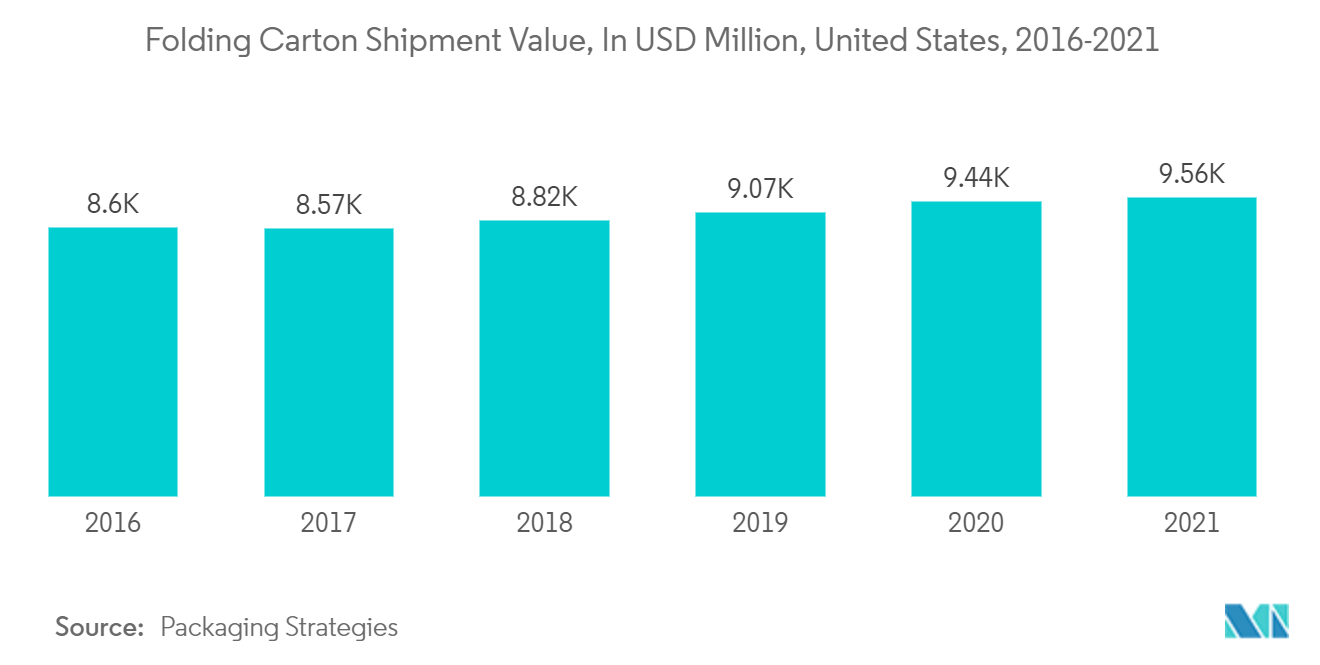
Asia Pacific Expected to Dominate the Flexographic Printing Market
- The e-commerce industry in the region is growing rapidly, which is one of the significant factors fueling the adoption of flexographic printing machines over the forecast period, as flexographic printing plays an essential role in the printing of labels and corrugated cardboard that are widely adopted across the industry. For instance, according to Invest India, the Indian e-commerce market is estimated to be worth over USD 55 billion in gross merchandise value in 2021. It is set to reach USD 350 billion by 2030.
- The growth of the logistics industry in the region, which is one of the biggest consumers of packaging and print labels, is expected to boost the market growth over the forecast period.
- Also, the growing initiatives by governments to boost the manufacturing industry in the region are one of the prominent factors that would increase the adoption of flexographic printing machines over the forecast period.
- Some of the prominent players in the market are entering the region through strategic partnerships in order to boost the market footprint. Such partnerships are expected to expose the region to new and innovative product offerings, fueling the adoption of flexographic printing machines over the forecast period.
- Asia Pacific is dominating the global commercial printing market and is expected to witness the similar growth over the coming years owing to the increasing consumption of commercial printing in emerging economies such as China, India, and Japan along with Indonesia, Thailand, and Vietnam.
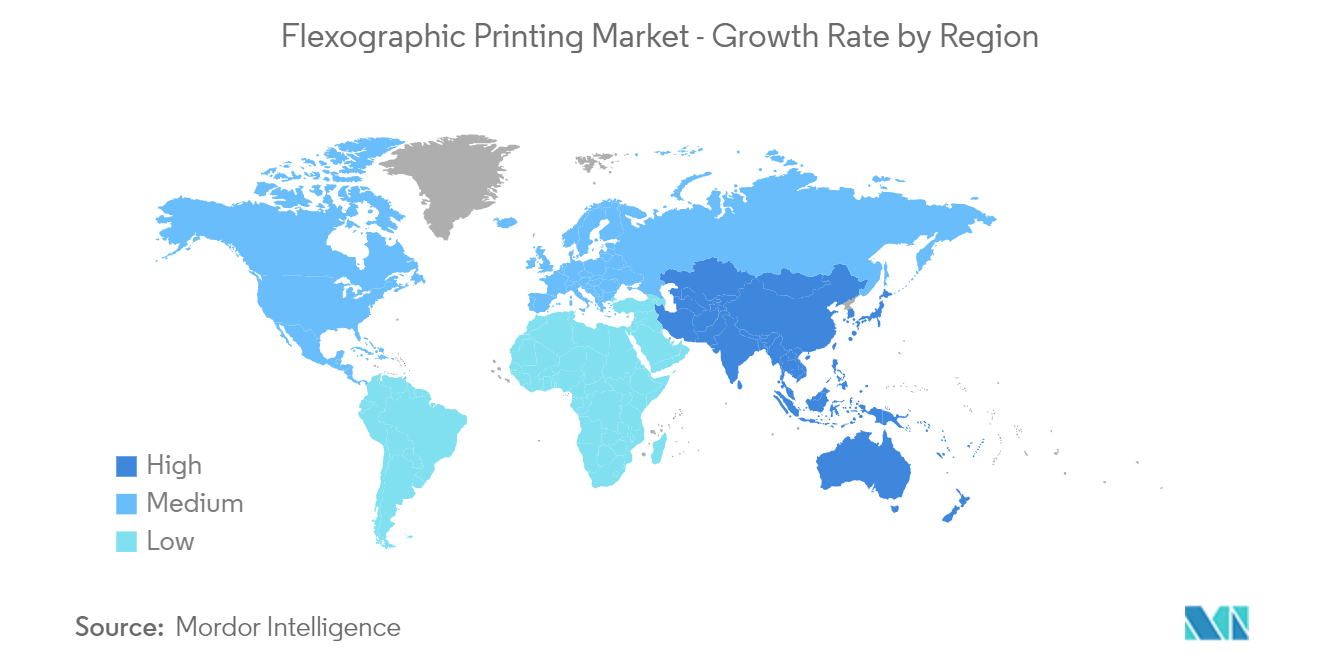
Flexographic Printing Industry Overview
The flexographic printing market is moderately fragmented, with the presence of several companies. In terms of market share, few of the major players currently dominate the market. These major players with a significant share of the market are aiming to expand their customer base across other countries. These companies leverage strategic collaborative initiatives to augment their market share and increase profitability.
October 2022 - AV Flexologic and BOBST partnered to integrate BOBST smart GPS with the complete AV Flexologic mounting machine range. The flexo industry advances toward a leaner, waste-free, and optimized printing process by combining this advanced press automation technology with swift and accurate flexo plate mounters.
September 2022 - Oasis Flower Plant for Plastic, the leading provider of PET preforms and HDPE closures in Saudi Arabia, reached an agreement to acquire a Comexi F2 MB flexo press, as it primarily seeks printing projects to suit the demands of diverse customers, particularly those in the beverage sector. The Asian company has chosen to rely on Comexi's knowledge and technology.
Flexographic Printing Market Leaders
-
Wolverine Flexographic LLC
-
Amcor PLC
-
Westrock Company
-
Bobst Group SA
-
Comexi
*Disclaimer: Major Players sorted in no particular order
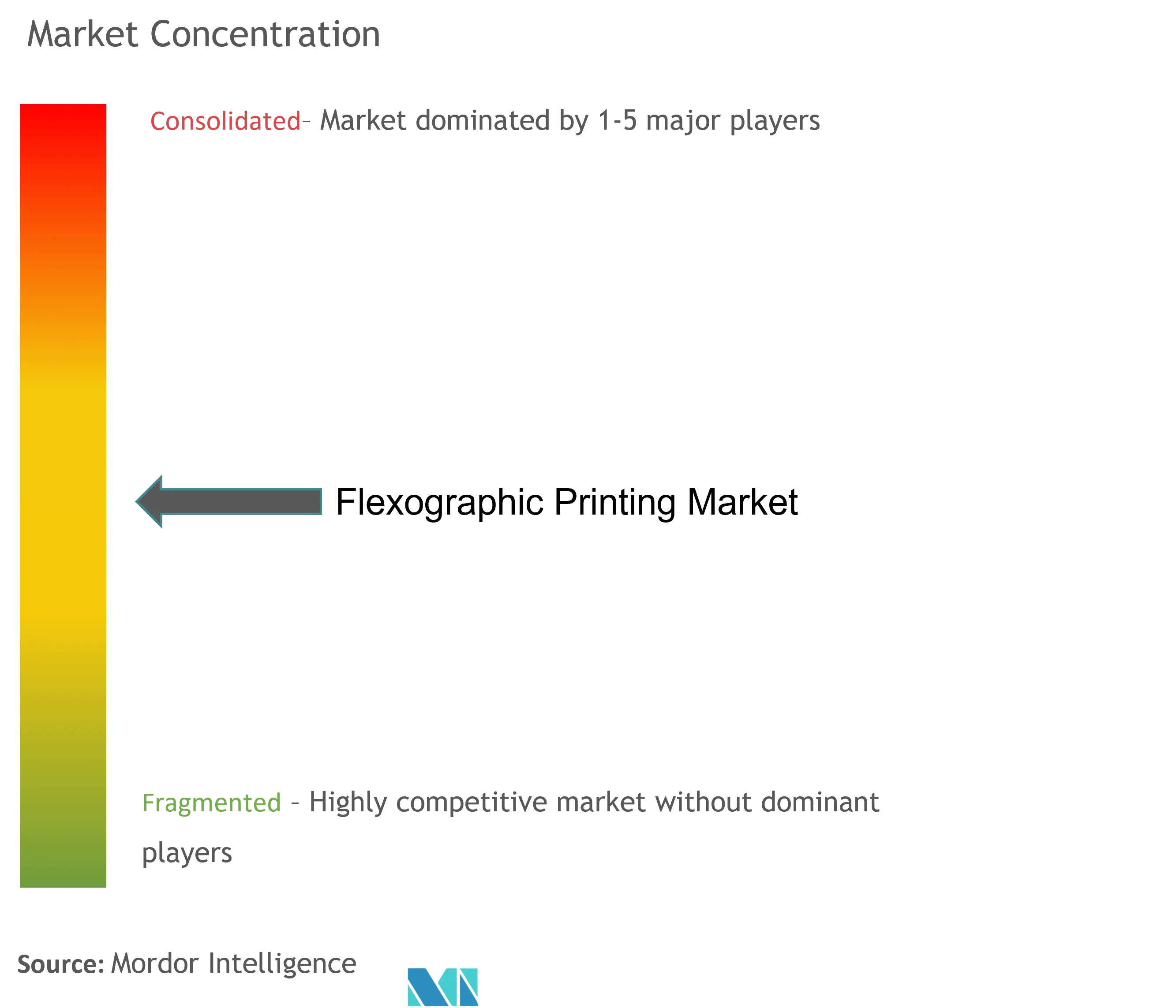
Flexographic Printing Market News
- October 2022 - Comexi unveiled the F2 Origin, the new reference of flexographic printing presses. The Comexi F2 Origin, a brand-new piece of Comexi F2 flexo equipment, includes GeniusTech innovations to increase productivity, ergonomics, and printing quality while reducing operator dependence. This new machine has an upgraded design and will be made available to customers in the following year.
- March 2022 - With the introduction of the new DIGITAL MASTER series, BOBST is expanding its All-in-One, All-Inline range by using its established flexo expertise and recent breakthrough inkjet developments. The DIGITAL MASTER 340 and DIGITAL MASTER 510 will change how labels are manufactured. They provide a fully automated digital production line with printing, embellishment, and cutting capabilities.
Flexographic Printing Market Report - Table of Contents
1. INTRODUCTION
- 1.1 Study Assumptions and Market Definition
- 1.2 Scope of the Study
2. RESEARCH METHODOLOGY
3. EXECUTIVE SUMMARY
4. MARKET INSIGHTS
- 4.1 Market Overview
-
4.2 Industry Attractiveness - Porter's Five Forces Analysis
- 4.2.1 Threat of New Entrants
- 4.2.2 Bargaining Power of Buyers/Consumers
- 4.2.3 Bargaining Power of Suppliers
- 4.2.4 Threat of Substitute Products
- 4.2.5 Intensity of Competitive Rivalry
- 4.3 Industry Value Chain Analysis
- 4.4 Assessment of the Impact of COVID-19 on the Market
5. MARKET DYNAMICS
-
5.1 Market Drivers
- 5.1.1 Lesser Printing Cost
- 5.1.2 Technological Advancements and Improved Print Quality
-
5.2 Market Restraints
- 5.2.1 Advent of New Printing Technologies
6. FLEXOGRAPHIC PRINT EQUIPMENT MARKET LANDSCAPE
- 6.1 Narrow Web
- 6.2 Medium Web
- 6.3 Sheet Fed
- 6.4 Other Printing Equipment
7. MARKET SEGMENTATION
-
7.1 Application
- 7.1.1 Corrugated Boxes
- 7.1.2 Folding Carton
- 7.1.3 Flexible Packaging
- 7.1.4 Labels
- 7.1.5 Print Media
- 7.1.6 Other Applications
-
7.2 Geography
- 7.2.1 North America
- 7.2.1.1 United States
- 7.2.1.2 Canada
- 7.2.2 Europe
- 7.2.2.1 United Kingdom
- 7.2.2.2 Germany
- 7.2.2.3 France
- 7.2.2.4 Italy
- 7.2.2.5 Spain
- 7.2.2.6 Rest of Europe
- 7.2.3 Asia-Pacific
- 7.2.3.1 China
- 7.2.3.2 India
- 7.2.3.3 Japan
- 7.2.3.4 Rest of Asia-Pacific
- 7.2.4 Latin America
- 7.2.5 Middle East and Africa
8. COMPETITIVE LANDSCAPE
-
8.1 Company Profiles
- 8.1.1 Amcor PLC
- 8.1.2 Westrock Company
- 8.1.3 Constantia Flexibles GmbH
- 8.1.4 Sonoco Products Company
- 8.1.5 Janoschka Holding GmbH
- 8.1.6 InterFlex Group
- 8.1.7 Pepin Manufacturing, Inc
- 8.1.8 Siva Group
- 8.1.9 Flexopack SA
- 8.1.10 Southern Coating & Nameplate Inc.
- 8.1.11 Wolverine Flexographic LLC (Crosson Holdings LLC)
- 8.1.12 Bobst Group SA
- 8.1.13 Edale UK Limited
- 8.1.14 Heidelberger Druckmaschinen AG
- 8.1.15 OMET
- 8.1.16 MPS Systems BV
- 8.1.17 Star Flex International
- 8.1.18 Comexi
- 8.1.19 Windmoeller & Hoelscher Corporation
- 8.1.20 Orient Sogyo Co. Ltd.
- *List Not Exhaustive
9. INVESTMENT ANALYSIS
10. FUTURE OF THE MARKET
** Subject To AvailablityFlexographic Printing Industry Segmentation
Flexographic printing is a printing process that utilizes flexible plates formed of rubber or plastic. Each plate, with its lightly raised image, is wheeled on a cylinder and spread with fast-drying ink. The substance to be printed on, or the substrate, is passed between the print plate and the impression roller, which uses pressure to keep the substrate against the plate. The study considers the revenue generated from selling various types of flexographic printing inks and equipment provided by vendors operating in the market.
The Flexographic Printing Market is segmented by Application (Corrugated Boxes, Folding Carton, Flexible Packaging, Labels, Print Media) and Geography (North America, Europe, Asia-Pacific, Latin America, Middle East and Africa). The market sizes and forecasts are provided in terms of value (USD million) for all the above segments.
| Application | Corrugated Boxes | |
| Folding Carton | ||
| Flexible Packaging | ||
| Labels | ||
| Print Media | ||
| Other Applications | ||
| Geography | North America | United States |
| Canada | ||
| Geography | Europe | United Kingdom |
| Germany | ||
| France | ||
| Italy | ||
| Spain | ||
| Rest of Europe | ||
| Geography | Asia-Pacific | China |
| India | ||
| Japan | ||
| Rest of Asia-Pacific | ||
| Geography | Latin America | |
| Middle East and Africa |
Flexographic Printing Market Research FAQs
How big is the Flexographic Printing Market?
The Flexographic Printing Market size is expected to reach USD 196.24 billion in 2024 and grow at a CAGR of 3.13% to reach USD 228.90 billion by 2029.
What is the current Flexographic Printing Market size?
In 2024, the Flexographic Printing Market size is expected to reach USD 196.24 billion.
Who are the key players in Flexographic Printing Market?
Wolverine Flexographic LLC, Amcor PLC, Westrock Company, Bobst Group SA and Comexi are the major companies operating in the Flexographic Printing Market.
Which is the fastest growing region in Flexographic Printing Market?
Asia Pacific is estimated to grow at the highest CAGR over the forecast period (2024-2029).
Which region has the biggest share in Flexographic Printing Market?
In 2024, the Asia Pacific accounts for the largest market share in Flexographic Printing Market.
What years does this Flexographic Printing Market cover, and what was the market size in 2023?
In 2023, the Flexographic Printing Market size was estimated at USD 190.28 billion. The report covers the Flexographic Printing Market historical market size for years: 2019, 2020, 2021, 2022 and 2023. The report also forecasts the Flexographic Printing Market size for years: 2024, 2025, 2026, 2027, 2028 and 2029.
Flexographic Printing Industry Report
Statistics for the 2024 Flexographic Printing market share, size and revenue growth rate, created by Mordor Intelligence™ Industry Reports. Flexographic Printing analysis includes a market forecast outlook to 2029 and historical overview. Get a sample of this industry analysis as a free report PDF download.



